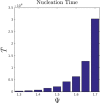The evolution of distributed sensing and collective computation in animal populations
- PMID: 26652003
- PMCID: PMC4755780
- DOI: 10.7554/eLife.10955
The evolution of distributed sensing and collective computation in animal populations
Abstract
Many animal groups exhibit rapid, coordinated collective motion. Yet, the evolutionary forces that cause such collective responses to evolve are poorly understood. Here, we develop analytical methods and evolutionary simulations based on experimental data from schooling fish. We use these methods to investigate how populations evolve within unpredictable, time-varying resource environments. We show that populations evolve toward a distinctive regime in behavioral phenotype space, where small responses of individuals to local environmental cues cause spontaneous changes in the collective state of groups. These changes resemble phase transitions in physical systems. Through these transitions, individuals evolve the emergent capacity to sense and respond to resource gradients (i.e. individuals perceive gradients via social interactions, rather than sensing gradients directly), and to allocate themselves among distinct, distant resource patches. Our results yield new insight into how natural selection, acting on selfish individuals, results in the highly effective collective responses evident in nature.
Keywords: Collective Behavior; Decision-making; Explore-exploit; Optimization; Physical Computation; Swarm; ecology; evolutionary biology; genomics; none.
Conflict of interest statement
IDC: Reviewing editor,
The other authors declare that no competing interests exist.
Figures
























Similar articles
-
Computing in fish schools.Elife. 2016 Jan 18;5:e12852. doi: 10.7554/eLife.12852. Elife. 2016. PMID: 26780669 Free PMC article.
-
Collective dynamics of self-propelled particles with variable speed.Phys Rev E Stat Nonlin Soft Matter Phys. 2012 Jul;86(1 Pt 1):011901. doi: 10.1103/PhysRevE.86.011901. Epub 2012 Jul 2. Phys Rev E Stat Nonlin Soft Matter Phys. 2012. PMID: 23005446
-
Individual and collective encoding of risk in animal groups.Proc Natl Acad Sci U S A. 2019 Oct 8;116(41):20556-20561. doi: 10.1073/pnas.1905585116. Epub 2019 Sep 23. Proc Natl Acad Sci U S A. 2019. PMID: 31548427 Free PMC article.
-
Swarm intelligence in fish? The difficulty in demonstrating distributed and self-organised collective intelligence in (some) animal groups.Behav Processes. 2017 Aug;141(Pt 2):141-151. doi: 10.1016/j.beproc.2016.10.005. Epub 2016 Oct 11. Behav Processes. 2017. PMID: 27737770 Review.
-
Bringing a Time-Depth Perspective to Collective Animal Behaviour.Trends Ecol Evol. 2016 Jul;31(7):550-562. doi: 10.1016/j.tree.2016.03.018. Epub 2016 Apr 19. Trends Ecol Evol. 2016. PMID: 27105543 Review.
Cited by
-
Local interactions and their group-level consequences in flocking jackdaws.Proc Biol Sci. 2019 Jul 10;286(1906):20190865. doi: 10.1098/rspb.2019.0865. Epub 2019 Jul 3. Proc Biol Sci. 2019. PMID: 31266425 Free PMC article.
-
Collective animal navigation and migratory culture: from theoretical models to empirical evidence.Philos Trans R Soc Lond B Biol Sci. 2018 May 19;373(1746):20170009. doi: 10.1098/rstb.2017.0009. Philos Trans R Soc Lond B Biol Sci. 2018. PMID: 29581394 Free PMC article. Review.
-
Collective predator evasion: Putting the criticality hypothesis to the test.PLoS Comput Biol. 2021 Mar 15;17(3):e1008832. doi: 10.1371/journal.pcbi.1008832. eCollection 2021 Mar. PLoS Comput Biol. 2021. PMID: 33720926 Free PMC article.
-
Spatial confinement affects the heterogeneity and interactions between shoaling fish.Sci Rep. 2024 May 29;14(1):12296. doi: 10.1038/s41598-024-63245-y. Sci Rep. 2024. PMID: 38811673 Free PMC article.
-
Comparison of solitary and collective foraging strategies of Caenorhabditis elegans in patchy food distributions.Philos Trans R Soc Lond B Biol Sci. 2020 Sep 14;375(1807):20190382. doi: 10.1098/rstb.2019.0382. Epub 2020 Jul 27. Philos Trans R Soc Lond B Biol Sci. 2020. PMID: 32713303 Free PMC article.
References
-
- Bachmayer R, Leonard NE. Proceedings of 41st IEEE Conf. on Decision and Control. 2002. Vehicle networks for gradient descent in a sampled environment; pp. 112–117.
-
- Bertrand A, Gerlotto F, Bertrand S, Gutiérrez M, Alza L, Chipollini A, Díaz E, Espinoza P, Ledesma J, Quesquén R, Peraltilla S, Chavez F. Schooling behaviour and environmental forcing in relation to anchoveta distribution: an analysis across multiple spatial scales. Progress in Oceanography. 2008;79:264–277. doi: 10.1016/j.pocean.2008.10.018. - DOI
Publication types
MeSH terms
LinkOut - more resources
Full Text Sources

